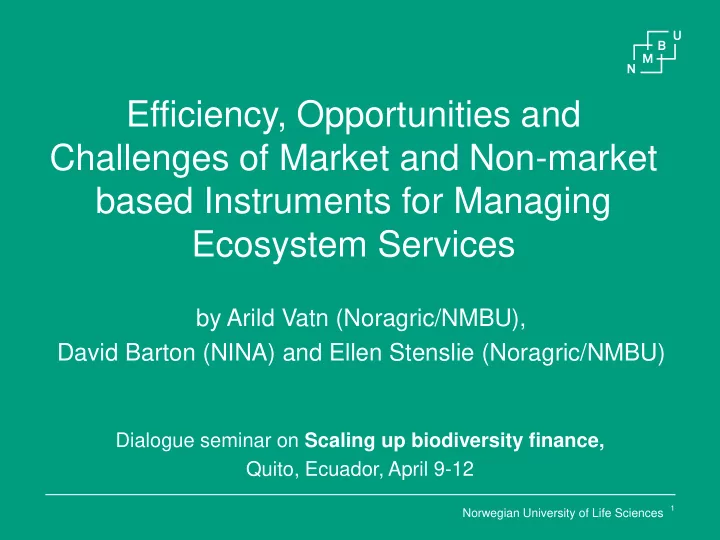

Efficiency, Opportunities and Challenges of Market and Non-market based Instruments for Managing Ecosystem Services by Arild Vatn (Noragric/NMBU), David Barton (NINA) and Ellen Stenslie (Noragric/NMBU) Dialogue seminar on Scaling up biodiversity finance, Quito, Ecuador, April 9-12 1 Norwegian University of Life Sciences
1. Introduction • The presentation is based on material from a study we are undertaking for Norad on market/non-market instruments • The project started quite recently. Here I will give examples of a few core elements from the study – Classifying policy instruments – Financialization – experiences from CDM – Distributional effects of PES and CDM Norwegian University of Life Sciences 2
2. Classifying policy instruments Legal rules Economic instruments Information (command and control) (public or private control) Public Legal Information Pure public Markets provision protection - Technical instruments - Non-liability -ing - National - Normative - Taxes and based parks Education/develop fees (voluntary) - Reserves -ment of skills - Subsidies - Liability - Etc. - Fiscal based transfers Government/public action : Defining rights (the resource regime) and rules for interaction between actors. Maybe also defining the service. Norwegian University of Life Sciences 3
2. Classifying economic instruments (cont.) Types of markets for ES Direct Market with intermediaries market Complete Incomplete (between (all transactions – a) and (combination of trade- seller and b) – trade based) based and non-trade buyer) based transactions) Non-liability based (voluntary) Liability based Buyer Intermediary Seller a) b) Note that intermediaries may be private businesses, NGOs, but also public agents Norwegian University of Life Sciences 4
2. Classifying economic instruments (cont.) Types of markets for ES Direct Market with intermediaries market Complete Incomplete (between (all transactions – a) and (combination of trade- seller and b) – trade based) based and non-trade buyer) based transactions) Non-liability based (voluntary) Liability based (cap- and-trade) Buyer Intermediary Seller a) b) Note that intermediaries may be private businesses, NGOs, but also public agents Norwegian University of Life Sciences 5
2. Classifying economic instruments (cont.) Types of markets for ES Direct Market with intermediaries market Complete Incomplete (between (all transactions – a) and (combination of trade- seller and b) – trade based) based and non-trade buyer) based transactions) Non-liability Vitel case Some market PES systems Most market PES systems based (PES) - water, biodiversity, - water, biodiversity, (voluntary) carbon carbon Certification schemes EU ETS – EU ETS Some CDM projects Liability bilateral CDM (private buyers) (public buyers) based (cap- trades Biodiversity offsets and-trade) Norwegian University of Life Sciences 6
3. Financialization: Experiences from CDM Norwegian University of Life Sciences 7
3. Financialization: Experiences from CDM • What explains the difference between prices on primary and secondary CERs – Risks are (much) higher for trades in the primary market – Transaction costs (including issuing/verification) – Information rents – intermediaries have advantages • Effects of a collapse of CDM for developing countries – A lot of projects will not be realized – We see the importance of (lacking) political decisions – i.e., no Post-Kyoto – for the viability of markets • Environmental consequences of a collapsing CDM – Due to somewhat weak additionality, the problem on this side is maybe less. • Do we need to handle risks the way CDM does. What about an international fund that issues allowances/CERs? Norwegian University of Life Sciences 8
4. Distributional effects of PES and CDM • Win-win? – Who is paid? – Level of payment compared to costs – Format of payments • Who gets paid – the main picture – Land owners , dominantly private and larger land owners – Women tend to be excluded . Note also issues regarding elite capture in case of community based programs – Regarding plantations , payments tend to go to concessionaries – Land and the products from the land more expensive – Results depend on who the intermediary is – the goals set for the program • Why are the poor weakly involved – core aspects – Opportunity costs higher for those with little land – TCs higher for small-holder oriented programs – The poor are less well informed Norwegian University of Life Sciences 9
4. Distributional effects of PES and CDM • Level of payments – Generally (much) lower than opportunity costs . Then comes also transaction costs on top of this (sellers may not cover these, though) – Other gains than payments – e.g., • from the conservation itself • increased tenure security – Some disagreements in the literature on this issue • Format of payments – Cash seems to dominate; but some in-kind – In the case of community projects, we observe a mix of individual payments and payments to the community – the latter seems dependent on the level of trust – The emphasis on PES being successful only if educational programs are involved – changing practices is profound Norwegian University of Life Sciences 10
Recommend
More recommend